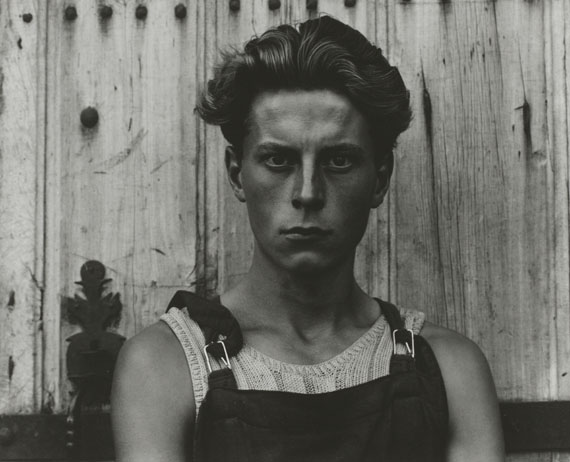
Young Boy, Gondeville, Charente, France, 1951
Gelatin-silver print, 19.4 × 24.4 cm
Philadelphia Museum of Art, The Paul Strand Collection
© Estate of Paul Strand
Paul Strand »
Photography and Film for the 20th Century
Fotografie und Film für das 20. Jahrhundert
Exhibition: 7 Mar – 17 Jul 2015
Fri 6 Mar 18:00

Fotomuseum Winterthur
Grüzenstr. 44+45
8400 Winterthur
+41 (0)52-2341060
info@fotomuseum.ch
www.fotomuseum.ch
temp. closed
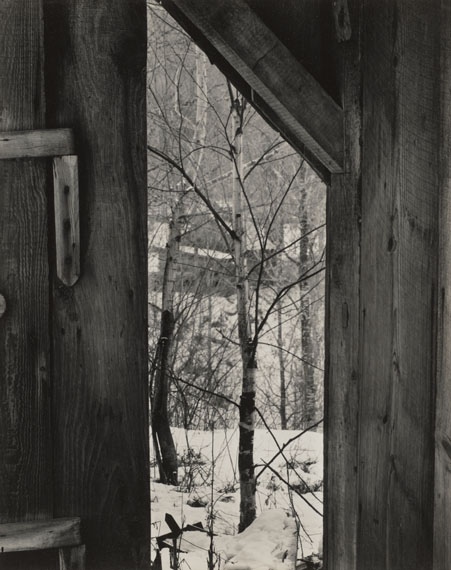
Toward the Sugar House, Vermont (Blick auf das Sugar House), 1944
Silbergelatine-Abzug, 24.4 × 19.4 cm
Philadelphia Museum of Art, The Paul Strand Collection
© Estate of Paul Strand
"Paul Strand – Photography and Film for the 20th Century"
Exhibition: 7 March – 17 May 2015
Opening: Friday, 6 March, 18-21 h
Fotomuseum Winterthur presents the first major retrospective in Europe of the work of Paul Strand (1890–1976), one of the great modernist photographers of the twentieth century. Drawing from a recent major acquisition of 3,000 prints by the Philadelphia Museum of Art, the exhibition shows the evolution of Strand's work over six decades. It reveals the multiplicity of his practice, from his early efforts to secure photography's position as a modernist art form, to his embrace of film-making, to his powerful evocation of people and place in his post-war photo books. Strand is revealed as a complex and contradictory figure: a stubborn aesthete, a communist sympathiser and a pastoralist motivated by a strong sense of social purpose.
The exhibition begins with Strand's rapid mastery of the prevailing Pictorialist style of the 1910s and his growing interest a few years later in abstraction. We see him attempting to incorporate into photography some of the key lessons of contemporary art, especially Cubism and the work of American artists, championed by Alfred Stieglitz, including Georgia O’Keeffe. At the same time, Strand began to explore urban subject matter, including a remarkable series of close-up portraits of people taken anonymously on the streets of New York. He was investigating the capacity of the camera to record modern life and was particularly interested in its ability mechanically to capture mesmerizing detail. The exhibition includes Strand's first short film, Manhatta (1921), a 'city symphony' dedicated to New York, made together with the artist Charles Sheeler. At once romantic and highly formal, it is considered the first American avant-garde film.
Strand was always interested in travel and in particular the capacity of the camera to reveal the qualities of place and events that would otherwise not be encountered. Between 1932 and 1934 he photographed in Mexico, a country which had a profound effect on him, deepening his engagement with the politics of the left. Here he made a remarkable series of portraits, placing a prism on the lens of his Graflex camera so as to make images surreptitiously. Strand was also interested in the context of Mexican peasant life, making an equally remarkable series of images of bultos, the carved and painted religious figures in Mexican churches. Strand's romantic anti-modernity begins to be articulated in these images, an effort to articulate a quality of life that he felt was being lost.
Deeply impacted by the world economic crisis of the 1930s, Strand took an increasing interest in film-making as a means of encouraging social change. It would dominate much of his creative work over the next decade. The exhibition includes excerpts from two important films, Redes (1936) and Native Land (1942). Set in Mexico, the former is a fictional account of a fishing village struggling to overcome the exploitation of a corrupt boss. The latter, narrated by Paul Robeson, is Strand's most ambitious film and was created after he returned to New York to set up Frontier Films, a company making left-wing documentaries. Blending fictional scenes and documentary footage, Native Land focuses on union-busting in the 1930s from Pennsylvania to the Deep South. Strand's films reveal the extent of his political commitments, but equally the limits on his filmmaking ambitions as America became embroiled in the Second World War.
After 1945, Strand devoted his energies primarily to the production of photo books, offering him the opportunity to create complex portraits of people and place. He published Time in New England in 1950, a book which conveyed a sense of the intersection of past and present to evoke a tradition in American culture of tolerance, liberty and democratic freedoms. These were important issues for Strand as during the same year he moved to France in response to the growing anti-Communist witch-hunts in the U.S. Here he would continue to search for communities that reflected his political ideals, in particular the Italian village of Luzzara in the Po River Valley which was published as Un Paese: Portrait of an Italian Village in 1955. Influenced by Cesare Zavattini's neo-realist aesthetics the book concentrated on portraits of the villagers in their contexts of work and home, a moving homage to the qualities of everyday life.
Strand also photographed extensively in Africa and in 1963 he was invited to Ghana at the invitation of Kwame Nkrumah, its first president following the end of British rule. Fascinated by Ghana’s emerging democracy during these years, Strand was excited to photograph a place undergoing rapid modernization. His book, published eventually as Ghana: An African Portrait (1976), presents a sense of Ghanaian modernity unfolding alongside traditional culture. Strand was clearly energised by the vibrant public life of the country and the book's portraits are complemented by remarkable street pictures showing meetings, political rallies and outdoor markets.
Strand died at his home in Orgeval, outside Paris in 1976 aged 85. In his later years he frequently photographed his garden and the exhibition ends with a series of his lyrical Orgeval still lifes. These images extend the meditative exploration of nature he had begun in the 1920s and dwell on the domestic pleasures of a garden cultivated over twenty years.
The exhibition is accompanied by a substantial scholarly catalogue, co-published by the Philadelphia Museum of Art and Yale University Press in collaboration with Fundación MAPFRE, priced CHF 69.
"Paul Strand – Photography and Film for the 20th Century" is organised by the Philadelphia Museum of Art in collaboration with Fundación MAPFRE. It is curated by Peter Barberie, the Brodsky Curator of Photographs, Alfred Stieglitz Center at the Philadelphia Museum of Art, with the assistance of Amanda N. Bock, Project Assistant Curator of Photographs.�
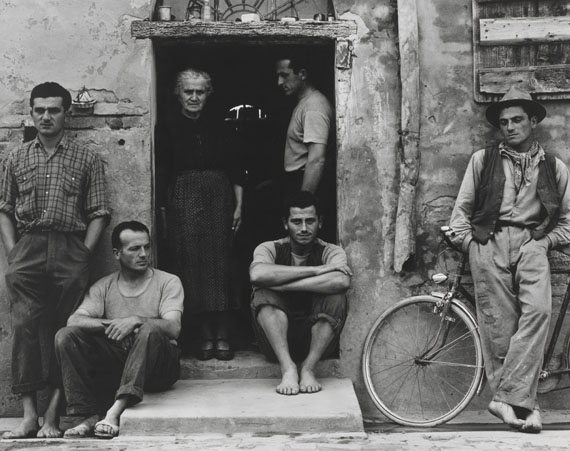
The Family, Luzzara (The Lusettis), 1953
Gelatin-silver print, 29 x 37 cm
Philadelphia Museum of Art, The Paul Strand Collection
© Estate of Paul Strand
"Paul Strand – Fotografie und Film für das 20. Jahrhundert"
Ausstellung: 7. März bis 17. Mai 2015
Vernissage: Freitag, 6. März, 18-21 Uhr
Das Fotomuseum Winterthur präsentiert die erste gross angelegte europäische Retrospektive zum Werk von Paul Strand (1890–1976), einem herausragenden Vertreter der modernen Fotografie des 20. Jahrhunderts. Auf der Grundlage einer beträchtlichen Neuerwerbung von 3000 Abzügen, die das Philadelphia Museum of Art vor kurzem gemacht hat, zeichnet die Ausstellung die Entwicklung von Strands Werk während sechs Jahrzehnten nach. Sie zeigt die Vielseitigkeit seines Schaffens, von seinen frühen Bemühungen, die Fotografie als eine moderne Kunstform zu etablieren, über sein starkes filmisches Interesse, bis hin zu den Fotobüchern der Nachkriegszeit, in denen Menschen und Orte auf beeindruckende Weise lebendig werden. Zum Vorschein kommt auch die komplexe und widersprüchliche Persönlichkeit Strands: der sture Ästhet, der Sympathisant mit dem Kommunismus, der am Ländlichen interessierte Fotograf mit einem ausgeprägten Sinn für soziale Fragen.
Die Ausstellung beginnt mit dem vorherrschenden, piktorialistischen Stil der 1910er Jahre, den Strand schnell meisterte, und seinem wachsenden Interesse an der Abstraktion wenige Jahre später. Beobachten lässt sich auch, wie er versuchte, Schlüsselerkenntnisse aus der zeitgenössischen Kunst, besonders aus dem Kubismus und den Arbeiten amerikanischer Künstler – allen voran Alfred Stieglitz, aber auch Georgia O'Keeffe – in die Fotografie aufzunehmen. Gleichzeitig widmete er sich urbanen Themen, etwa in der bemerkenswerten Reihe anonymer Nahaufnahmen von Menschen in den Strassen von New York City. Strand erforschte die Möglichkeiten, mit der Kamera das moderne Leben zu erfassen und interessierte sich besonders für ihr Potential, mechanisch faszinierende Einzelheiten aufzunehmen. In der Ausstellung wird Strands erster Kurzfilm Manhatta (1921) gezeigt, eine „Stadtsymphonie", die New York gewidmet ist und in Zusammenarbeit mit dem Künstler Charles Sheeler entstand. Der romantische und zugleich hochgradig formale Kurzfilm Manhatta, gilt heute als erster amerikanischer Avantgarde-Film überhaupt.
Strand interessierte sich stets für das Reisen und besonders für die Möglichkeiten der Kamera, Eigenschaften von Orten und Geschehnissen sichtbar zu machen, die anderweitig nicht erfahrbar sind. Zwischen 1932 und 1934 fotografierte er in Mexiko. Das Land beeindruckte ihn nachhaltig, was auch sein Engagement für linke politische Anliegen vertiefte. Er befestigt ein Prisma auf der Linse seiner Graflex-Kamera und schafft so eine beeindruckende Reihe von heimlich aufgenommenen Porträts. Weiter befasste sich Strand mit den Lebensumständen mexikanischer Bauern, daraus entstand die beeindruckende Bilderreihe der „Bultos", geschnitzten und bemalten religiösen Figuren in mexikanischen Kirchen. Strands romantische Abwendung vom Modernismus tritt in diesen Bildern erstmals hervor: Sie sind der Versuch, einen Aspekt des Lebens zum Ausdruck zu bringen, von dem er glaubt, dass er langsam verloren ging.
Stark getroffen von der Weltwirtschaftskrise in den 1930er Jahren, wandte sich Strand vermehrt dem Filmemachen als Werkzeug eines gesellschaftlichen Wandels zu. Der Film stand während des folgenden Jahrzehnts im Zentrum seines kreativen Schaffens. In der Ausstellung sind Ausschnitte aus zwei bedeutenden Filmen zu sehen, Redes (1936) und Native Land (1942). Redes spielt in Mexiko und ist ein fiktiver Bericht vom Kampf eines Fischerdorfes gegen die Ausbeutung durch einen korrupten Unternehmer. Native Land – mit Paul Robeson als Erzähler – ist Strands ambitioniertester Film. Er drehte ihn, nachdem er nach New York zurückgekehrt war, um das linke Dokumentarfilmlabel Frontier Films zu gründen. Mit einer Mischung aus fiktiven Szenen und dokumentarischem Material geht es bei Native Land um das „union busting", die Zerschlagung von Gewerkschaften, wie sie in den 1930er Jahren von Pennsylvania bis in den tiefsten Süden der USA praktiziert wurde. Strands Filme zeigen sein enormes politisches Engagement, machen aber auch klar, wie der Eintritt der USA in den Zweiten Weltkrieg seinen filmischen Ambitionen Grenzen setzte.
Nach 1945 widmete sich Strand hauptsächlich seinen Fotobüchern, in denen er komplexe Porträts von Menschen und Orten schuf. 1950 veröffentlichte er Time in New England, ein Buch, in dem sich Vergangenheit und Gegenwart zu überkreuzen scheinen und so eine Tradition der Toleranz, der Freiheit und der demokratischen Möglichkeiten in der amerikanischen Kultur heraufbeschwören. Diese Themen sind für Strand von grosser Bedeutung: Noch im gleichen Jahr zog er nach Frankreich, um der zunehmenden anti-kommunistischen Hexenjagd in den USA zu entgehen. Er suchte weiter nach Gemeinschaften, die seine politischen Ideale widerspiegelten, und befasste sich besonders mit dem italienischen Dorf Luzzara in der Po-Ebene. Daraus entstand 1955 sein Buch Un Paese: Portrait of an Italian Village, das von Cesare Zavattinis neorealistischer Ästhetik beeinflusst ist. Im Zentrum stehen Porträts der Dorfbewohner bei der Arbeit und zu Hause, eine bewegende Hommage an das Alltagsleben.
Strand fotografierte auch ausgiebig in Afrika und wurde 1963 von Kwame Nkrumah, dem ersten Präsidenten nach Ghanas Unabhängigkeit von Grossbritannien, eingeladen. Das Land wurde zügig modernisiert und Strand war fasziniert von der Demokratie, die in diesen Jahren in Ghana entstandt. Sein Buch, das erst 1976 unter dem Titel Ghana: An African Portrait erschien, vermittelt einen Eindruck von der ghanaischen Moderne, welche sich neben der traditionellen Kultur entfaltet. Strand wurde offensichtlich angesteckt vom lebhaften öffentlichen Leben im afrikanischen Land, und ergänzte die Porträts im Buch mit aussergewöhnlichen Strassenszenen von Versammlungen, politischen Kundgebungen und Marktszenen.
Paul Strand starb 1976, mit 85 Jahren, in seinem Haus in Orgeval ausserhalb von Paris. In seinen letzten Schaffensjahren fotografierte er häufig seinen Garten. Die Ausstellung schliesst mit einer Reihe seiner lyrischen Stillleben von Orgeval. Diese Aufnahmen greifen Strands meditative Auseinandersetzung mit der Natur aus den 1920er Jahren wieder auf. Sie verweilen bei den häuslichen Freuden eines über 20 Jahre hinweg kultivierten Gartens.
Zur Ausstellung erscheint ein ausführlicher wissenschaftlich fundierter Katalog, herausgegeben vom Philadelphia Museum of Art und Yale University Press in Zusammenarbeit mit der Fundación MAPFRE. Preis: CHF 69.
Die Ausstellung "Paul Strand – Fotografie und Film für das 20. Jahrhundert" wurde vom Philadelphia Museum of Art in Zusammenarbeit mit der Fundación MAPFRE entwickelt. Kuratorisch beteiligt waren: Peter Barberie, Brodsky Curator of Photographs, Alfred Stieglitz Center at the Philadelphia Museum of Art, unterstützt von Amanda N. Bock, Project Assistant Curator of Photographs.�
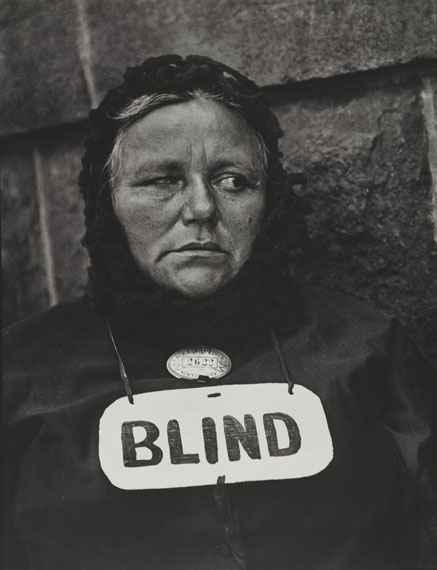
Blind Woman, New York, 1916
Gelatin-silver print, 32.4 × 24.8 cm
Colecciones FUNDACIÓN MAPFRE
© Estate of Paul Strand
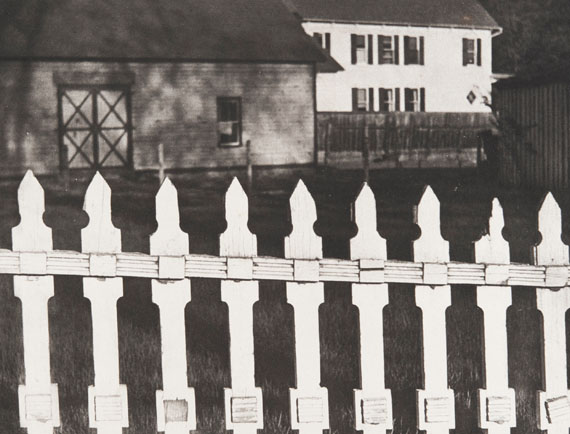
White Fence, Port Kent, New York (weisser Zaun), 1916
Silbergelatine-Abzug, 24.5 × 32.5 cm
Philadelphia Museum of Art, The Paul Strand Retrospective Collection
© Estate of Paul Strand